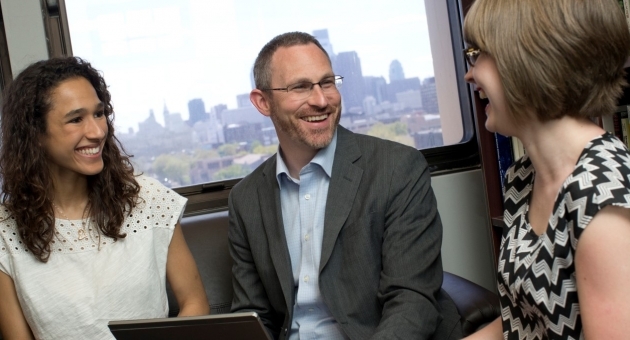Jason Chein knows what’s inside his students’ heads

Students often enter Jason Chein’s introductory cognitive psychology classes with, at best, a mild interest in the subject matter. But then Chein, CLA ’97, associate professor of psychology, begins underscoring the material’s everyday relevance.
“When we discuss the cognitive declines that can affect their older family members, students begin to realize this is not just esoteric material,” said Chein. “It’s something we all grapple with each day of our lives.”
The ability to demonstrate psychology’s real-world application is one reason Chein was named a recipient of a Lindback Award for Distinguished Teaching last spring.
One of Chein’s areas of research is memory. Specifically, he investigates the psychological and neurobiological underpinnings of working (or short-term) memory, and the role that working memory plays in supporting executive functioning, learning and decision making.
Currently, his lab is investigating the potential of training exercises to improve working memory and enhance attention focus. His work has been featured in The New York Times Magazine.
Chein’s interest in how the brain works started when he was a student at Temple. He originally majored in architecture but eventually gravitated to psychology and cognitive neuroscience. “The ability to study the brain noninvasively was cutting-edge, and I found it incredibly exciting,” he said.
After graduating from Temple, Chein went on earn a doctoral degree in cognitive psychology at the University of Pittsburgh. During a postdoctoral fellowship at Princeton University, Chein learned that Temple was seeking a faculty researcher adept in functional magnetic resonance imaging (fMRI), and the rest, as they say, is history.
“We knew adolescents were making riskier decisions when they were with their friends, but we didn’t know why,” said Laurence Steinberg, Distinguished University Professor and Laura H. Carnell Professor of Psychology at Temple, who along with Chein is today considered one of the world’s leading experts on adolescent decision making.
“Jason brought the brain science, which enabled us to discover the underlying processes that lead kids to take more risks in front of their friends.”
Using fMRI, Chein and Steinberg looked at brain activity in adolescents, young adults and adults as they made decisions in a simulated driving game, alone and in the presence of peers.
The goal of the game was to reach the end of a track as quickly as possible in order to maximize a monetary reward. Participants were forced to make a decision about whether to stop at a yellow light when they came to a given intersection or run through the intersection and risk colliding with another vehicle.
Taking the risk to run through the yellow light offered the potential payoff of moving through the intersection more quickly but also the consequence of a crash, which added a significant delay.
“Without an audience, when they decide (in a simulator) whether or not to run a yellow or red light, adult and adolescent brains function similarly,” said Chein. “But when adolescents know their peers are watching, the parts of their brains related to reward processing show increased activation and enhance their willingness to take a risk.”
Chein and Steinberg’s research has informed driver-license restrictions on the number of teenage passengers allowed in cars driven by teenagers, which have led to a reduction in fatal teen auto crashes.
- Bruce Beans